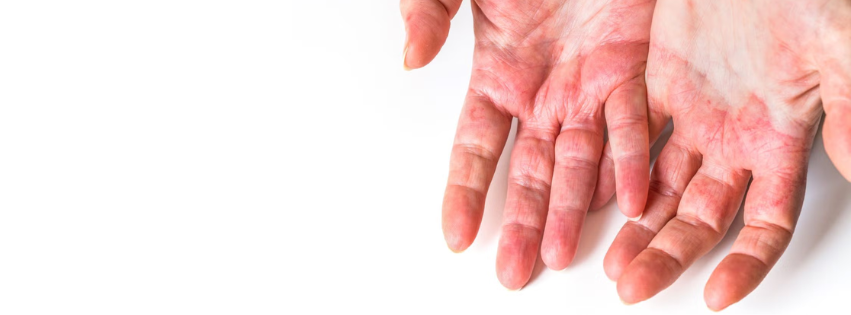
Coping with Atopic Dermatitis (Eczema) as an Adult
Information on what causes eczema and how to treat it.
 Chronic Hand Eczema: Treatment and Prevention | Allergy UK | National Charity
Chronic Hand Eczema: Treatment and Prevention | Allergy UK | National Charity
We use our hands every day but for people living with Chronic Hand Eczema (CHE), even simple tasks like washing, dressing, or preparing food can be painful.
CHE is a long-term inflammatory skin condition that affects the hands and wrists. It is considered chronic when it lasts longer than three months or recurs multiple times a year. Symptoms often include dryness, itching, skin cracking and persistent discomfort.
This guide offers practical advice on treatment options and prevention strategies to help manage flare-ups and protect your skin daily.

Information on what causes eczema and how to treat it.

Information on signs, symptoms and appropriate treatment.
CHE is often aggravated by repeated exposure to irritants, which can damage the skin barrier over time.
Common irritants include:
Taking action to protect and restore the skin barrier is a vital part of treatment for hand eczema.
Restoring:
Protecting:
Long-term management of CHE is often supported by making simple but meaningful changes in daily habits. This can be done by:
For those who continue to experience flare-ups despite taking precautions, seek advice from a healthcare professional as further support and investigations may be required to help manage your condition.
| Step | Actions |
| Moisturise | Daily, all over the affected area, carry an emollient. |
| Treat flares | Use prescribed treatments. |
| Protect hands | Wear non-latex gloves with cotton liners and emollient. |
| Avoid irritants | Use non-perfumed, mild cleansers |
| Prevent scratching | Cool compresses, gloves, and keep nails short. |
| Identify and manage triggers | Patch tests, limit stress and avoid allergens. |
You should seek help if your symptoms are getting worse, not improving, or if the condition is affecting your mental health or overall wellbeing. If you’re experiencing persistent sadness, loss of interest in activities, sleep problems or social withdrawal, it’s important to speak to a healthcare professional.
Moisturising your hands both morning, day and night, even when no eczema is visible, helps maintain a strong skin barrier. Using gloves with cotton liners while cleaning or doing manual tasks can significantly reduce flare-ups. Avoid hot water, soap and fragranced skincare products and cosmetics. Use gentle, non-perfumed alternatives designed for sensitive, eczema prone skin.
If your skin shows signs of infection, isn’t improving, or is beginning to affect your mental wellbeing, it’s important to seek advice from a healthcare provider.
It is important to Allergy UK that we can engage with all people that are affected by allergic disease
Join our mailing list



